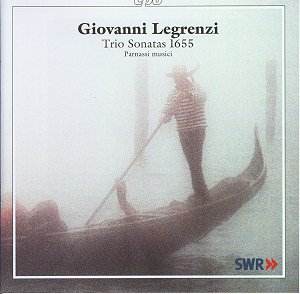La Cornara [02:41]
La Spilimberga [04:34]
La Fangipana [03:36]
La Strasolda [03:24]
La Col'Alta [03:38]
La Raspona [02:51]
La Donata [03:44]
La Foscari [02:53]
La Colloreta [02:25]
La Zabarella [03:41]
La Mont'Albana [04:04]
La Porcia [03:39]
La Valvasona [05:53]
La Querini [02:42]
La Torriana [04:18]
La Manina [03:48]
La Savorgnane [06:03]
Giovanni Legrenzi is
one of the key figures in the history
of Italian music in the second half
of the 17th century. Coming from a relatively
humble background - he was born in the
village of Clusone, near Bergamo, where
his father was violinist at the parish
church - his first post was that of
organist at S Maria Maggiore in Bergamo.
There he was responsible for the restoration
of the city to its former glory as a
music centre, which had fallen apart
after the death of Alessandro Grandi
during the plague of 1630.
Legrenzi left Bergamo
in 1655 and became maestro di cappella
in Ferrara the next year. By 1670 Legrenzi
was living in Venice, and here he played
a crucial role in the establishment
of the violin style of which Vivaldi
was an exponent.
The trio sonatas opus
2 which are recorded here were written
to be played during mass, a practice
which was widely spread in the Venetian
part of northern Italy. In Bergamo this
practice was introduced by Tarquinio
Merula and Giovanni Battista Buonamente.
In his liner notes Karl Böhmer
characterises Legrenzi's sonatas thus:
"In the early Legrenzi the imitative
beginning in a fast tempo is usually
still followed by the colorful sequence
of short movements merging together
that had marked the trio sonatas of
the early baroque period. But the form
(...) is already on the way to the sonata
in several movements with sharply demarcated
units." A good example of a sonata with
strongly contrasting sections is La
Spilimberga, the second item on
this disc.
Virtuosity is one of
the features of these sonatas. An impressive
example is the bassoon part of La
Donata. In La Porcia Legrenzi
uses the technique of pizzicato. Chromaticism
was one of the most frequently used
tools of expression at the time, which
is demonstrated by the opening phrase
of La Cornara, the very first
item on this disc. Legrenzi was also
a gifted composer of music for the theatre.
It is perhaps his dramatic talent which
is reflected in La Raspona with
its gradual increase in tempo and virtuosity.
It is interesting to
note that Johann Sebastian Bach used
a theme by Legrenzi in one of his organ
works. According to Robert Hill this
subject - which wasn't identified with
any certainty before - could derive
from the Sonata in c minor from opus
2. Unfortunately this statement in the
booklet doesn't make much sense as the
tracklist doesn't give the keys of the
sonatas.
The titles of the sonatas
refer to personalities in Northern Italy.
It is not quite clear whether this means
that these sonatas are a kind of musical
portraiture of these individuals. It
is also possible that the names are
given as a kind of reverence to them
and perhaps as a way to ask for their
patronage.
The ensemble Parnassi
musici has made some excellent recordings
before, and seems to be especially interested
in lesser-known repertoire. That is
also the case here. Important as Legrenzi's
trio sonatas may be from a historical
viewpoint, so far they have been largely
neglected, and their recording by Parnassi
musici is very welcome. The ensemble
gives a technically flawless performance,
with excellent ensemble playing. The
interpretation is vivid, energetic and
full of contrast. The virtuosity of
Sergio Azzolini on the bassoon is most
impressive. Even though these sonatas
are not meant to be performed and listened
to at a stretch, I didn't have any problems
doing so. That tells something about
the quality of both Legrenzi's sonatas
and this ensemble's performance.
Johan van Veen

